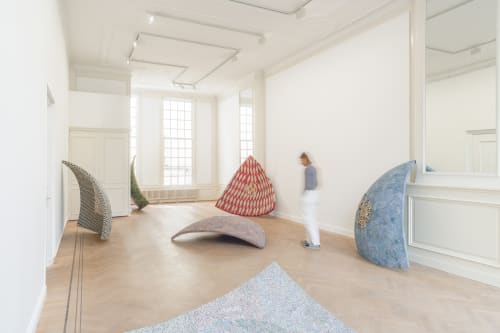Elias Sime: Tightrope: Concave Triangles
GRIMM is pleased to announce Tightrope: Concave Triangles, a solo exhibition of new works by Elias Sime. This is his second solo exhibition with the gallery, and in The Netherlands, on view at our Keizersgracht location in Amsterdam from August 28th.
Elias Sime is best known for his remarkable practice of converting used electronics into works that are both expansive and elaborately detailed. For years, the Ethiopian artist has sourced his materials from the large municipal market in Addis Ababa. He envisions a balance between the natural and man-made and his vision as an artist transcends conventions in contemporary art for its craftsmanship and social commentary—bearing the character of an idiosyncratic practice while containing overarching themes that are truly universal.
Tightrope: Concave Triangles presents a set of new sculptures made from thousands of small, identically cut pieces of timber glued together to make a sphere. When the sphere was cut in half, it became two domes. Then each dome was cut in halves, until it transformed into eight concave triangles.
The concaved shape represents unity, collaboration and love. In reality, the pieces are created individually, but symbolically they represent a sphere split in pieces. Each piece is covered with electric wires, dead watches, keyboards, and motherboards narrating different contemporary stories about current issues.
Elias started making these pieces about a year ago.
At the time, he was expanding on his earlier Tightrope series, where he was expressing his appreciation of and apprehension towards electronic technology, particularly smartphones. He often said that his work was about the need to slow down and question how these communication devices consume our time. He sees them as both productive and destructive. “When we walk slow” he said, “we see more, when we talk less, we learn more.” [...]
When Covid-19 overwhelmed the world, the narratives of his work changed. Elias once told me that this pandemic is redefining the concept of globalization. He said, “It feels like time has suddenly stopped ticking.” As the economy is collapsing and the virus continues to claim more lives, the only possible solution to overcome it is to start looking for the root of the problem. Pandemics have come and gone. Like nothing before, this one has confronted humanity by defying time and space. Covid-19 is merciless. It is invisible, odorless, untouchable, silent, and tasteless. It forced us to hide our identities with facemasks. Communication is a combination of spoken and body language. Often, the latter is louder than the former. When facial expressions are hidden, ulterior motives can only be read through the eyes. The distance Covid-19 created between us has interrupted our social norms. Our conversations are dominated by our fear of the uncertain future. Heroic and villainous stories of those who died saving lives and those who fibbed to stay in power seem to create a morphology of a new invisible deity called Covid-19.
I walked with Elias in his studio through the eight pieces selected for this exhibition. He said that each is about Covid-19 because its effect is unprecedented, and we are living in the midst of it. Indeed, we are all walking on a tightrope where the slightest mistake we make can cost us our lives. “Suddenly,” he said “time has stopped. We have nowhere to go but stop and rethink our values. Nothing is familiar anymore. It is as if the clocks have stopped ticking forcing us to look inward and examine how we got here and where we can go from here.” [...]
– By Meskerem Assegued




